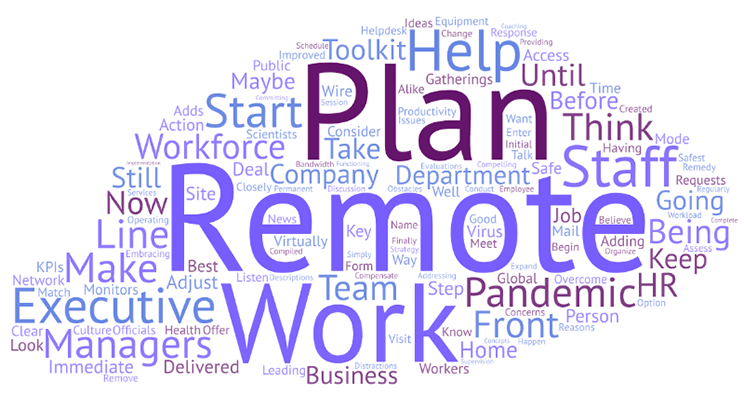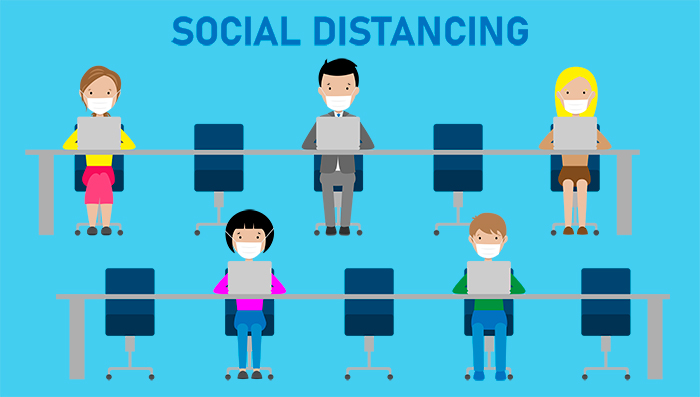Working from Home
- Details
- Working from Home

"It's almost August and we were hoping to be back in the office soon." This is the thought crossing the minds of business leaders across the USA. I'm sorry to say that progress against the coronavirus has gotten worse instead of better. It's just not safe to assemble in office spaces yet. So what do we do?
Office-based workers have been functioning reasonably well from home with cobbled-together equipment, furniture, and Zoom calls. But I'm hearing more and more about "Zoom fatigue." It's time to start addressing the reality that we're going to be working from home for much longer than we expected. Our work-from-home scenario could last anywhere from 1 to 3 years, depending on when a vaccine might be invented, whether it is effective, and when it will be globally distributed and available. Yes, I said "globally": the United States may have it the worst, but we have to be able to inoculate and protect everyone on the planet.
- Details
- Working from Home
 This is part 3 of a 3-part series on the impact that the COVID-19 pandemic has had on companies and their employees who are now required to work from home. You can read Part 1 here and Part 2 here. Smart companies are planning for the return of their employees to the workplace, but also considering making working from home a permanent option. Based on my 35,000 hours of work-from-home experience, here's an outline for how to accomplish an effective work-from-home policy and practice.
This is part 3 of a 3-part series on the impact that the COVID-19 pandemic has had on companies and their employees who are now required to work from home. You can read Part 1 here and Part 2 here. Smart companies are planning for the return of their employees to the workplace, but also considering making working from home a permanent option. Based on my 35,000 hours of work-from-home experience, here's an outline for how to accomplish an effective work-from-home policy and practice.
Even before the COVID-19 pandemic hit, working from home (WFH) was a reasonable option for employees. With fast Internet speeds available to homes, long-life laptop batteries, and multi-factor authentication to enhance security, employees could be as productive or potentially more productive working from home.
- Details
- Working from Home
 This is part 2 of a 3-part series on the impact that the COVID-19 pandemic has had on companies and their employees who are now required to work from home. (You can read Part 1 here.) Now that we're becoming adept at working from our homes, it's time to consider making that a permanent option.
This is part 2 of a 3-part series on the impact that the COVID-19 pandemic has had on companies and their employees who are now required to work from home. (You can read Part 1 here.) Now that we're becoming adept at working from our homes, it's time to consider making that a permanent option.
My current work-from-home scenario is not my first encounter with the joys and frustrations of carving out a place to work. In fact, I assembled my first home office back in 1991. (Now you know how I have accumulated 35,000 hours of work-from-home experience.)
I was sharing a 2-bedroom condo with a friend, and the only place to set up a home office for my newly-minted consulting business was in my bedroom. I already had a desk, a computer, a printer, and a couple of bookshelves. I added more bookshelves for storage and voilà! My office was 3 feet deep, 8 feet high, and 8 feet wide. In other words, it was all mounted to or pushed up against the wall. I worked that way for a year, supporting myself reasonably well for a first attempt at entrepreneurship. I eventually got a job again, but I have kept a home office ever since, hoping at some point to return to self-employment.
- Details
- Working from Home
 (Looking for the survey link? It's at the bottom...)
(Looking for the survey link? It's at the bottom...)
Working from home (WFH) is second nature for me; I've accumulated more than 35,000 hours of working from home, which includes the years I had my own business and the years I worked on contract for giant tech companies like Microsoft and Amazon.
I left full-time employment for Microsoft in 2003 after 10 years, to start and run my own business out of our house. For 2 years, I planned my departure and my office setup. I bought ergonomic furniture, file cabinets, bookshelves, and a business laptop. I even calculated cost of all the things that Microsoft had provided that I would now have to pay for myself, from my daily allotment of Diet Coke to extra toilet paper (sound familiar?).
Once I returned to Corporate America (mostly as a contractor), I kept my home office intact. I was fortunate to have a couple of jobs where I worked from home exclusively. So working from home is pretty comfortable for me, but I am definitely hearing from friends how difficult their work-from-home scenarios are now. I'll get to that in a minute.


